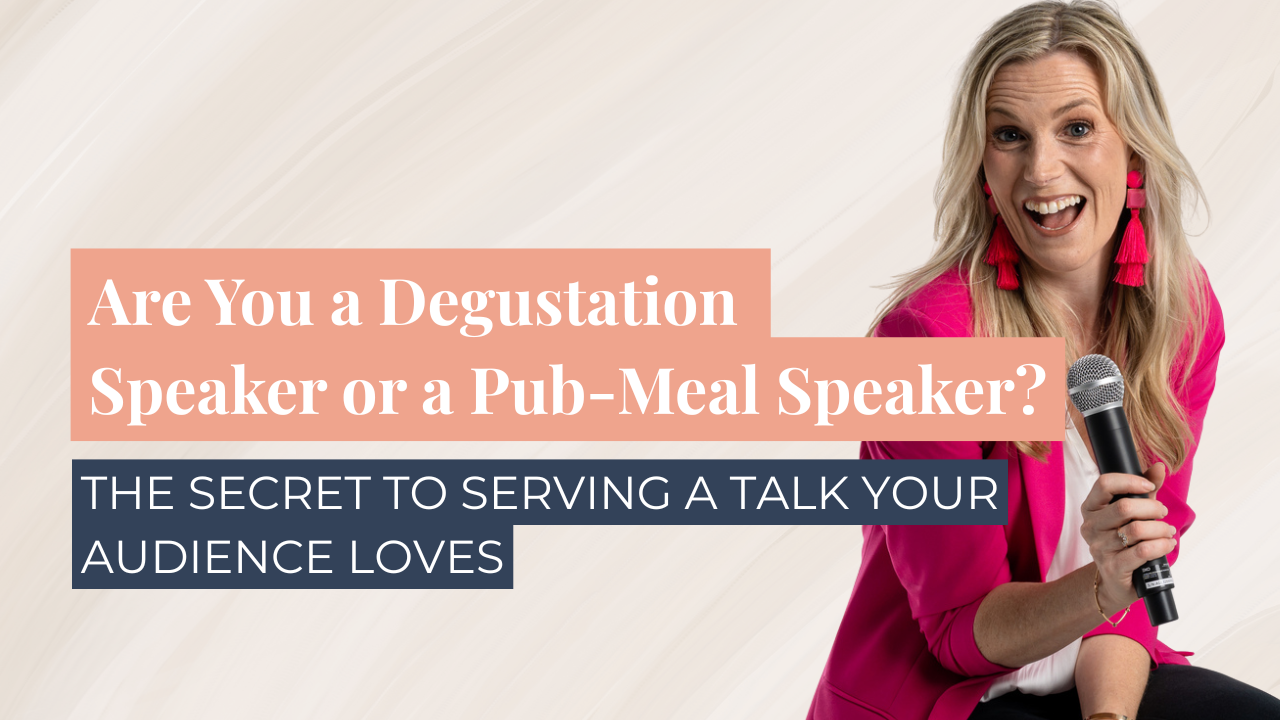Are You a Degustation Speaker or a Pub-Meal Speaker? The Secret to Serving a Talk Your Audience Loves
Oct 11, 2024
Something you should know about me: I am a HUGE foodie.
I love trying new restaurants, sharing meals with friends and family, and soaking up all the joy that good food and good company can bring.
Are you the same?
A few weeks ago, while out to dinner, I found myself thinking about women speaking on stage—and the connection between your speaking style and the way food is served.
Because in my experience, most women fall into one of two categories:
They’re either a delicate degustation…
or a “give-it-all-over” pub meal.
Let me explain.
The Degustation Speaker
A degustation speaker carefully curates their content.
They offer a beautifully crafted “chef’s selection” of ideas, stories, and metaphors that tantalise the taste buds of their audience.
Nothing is accidental.
Nothing is overwhelming.
They don’t give too much away—just enough to leave the audience satisfied, inspired, and wanting more.
When the audience leaves, they’re thinking:
“That was incredible.”
“She really knows her craft.”
“I want more of that experience.”
A degustation talk feels intentionally designed.
Elegant.
Memorable.
The Pub Meal Speaker
Then there’s the pub meal speaker.
They don’t know what the “best bits” are, so they slap EVERYTHING on the plate.
Oversized schnitzel? Check.
A mountain of chips? Check.
Side salad? Sauce? Garlic bread? A drink voucher? Dessert?
All piled on in hopes the audience will feel like they’re getting “value.”
Except… they don’t.
The audience leaves feeling full—but overwhelmed.
Stuffed with too much content.
And they never mention the speaker’s name again.
Because quantity doesn’t equal impact.
So which one is more successful?
Right.
The degustation speaker—every time.
Because less isn’t just more.
Less is strategic.
Less is intentional.
Less allows your audience to digest the experience and actually transform.
So how do you move from “pub meal” to “degustation”?
Here are three steps you can apply before, during, and after writing your talk:
1. BEFORE: Focus on Transformation Over Teaching
Your job isn’t to cram 300 tools into a single talk.
It’s to shift your audience’s perspective.
To spark insight.
To create an emotional and intellectual transformation.
Before you write a single word, ask:
What transformation do I want them to experience by the end?
Design your talk around that.
2. DURING: Leave Your Audience Wanting More
Especially if you’re selling from the stage, your talk should whet their appetite—not fill them up completely.
As you craft your talk, decide:
✨ What do they need to know now?
✨ What can wait until they work with you more deeply?
A degustation offers a taste, not the entire pantry.
3. AFTER: Spend Time Taking Things Away
Editing is where the magic happens.
Once your talk is written, go back and remove anything unnecessary.
Read it aloud and ask:
“Does this need to be said?”
“Does this move the story forward?”
“Does this support the transformation?”
What you remove is just as important as what you leave in.
So there you have it.
No more excuses for delivering talks that feel like pub meals when they could be elegant degustations.
Your audience doesn’t need more content.
They need more clarity, more connection, and more you.
Casey xx
Stay connected with news and updates!
Join our mailing list to receive the latest news and updates from our team.
Don't worry, your information will not be shared.
We hate SPAM. We will never sell your information, for any reason.


